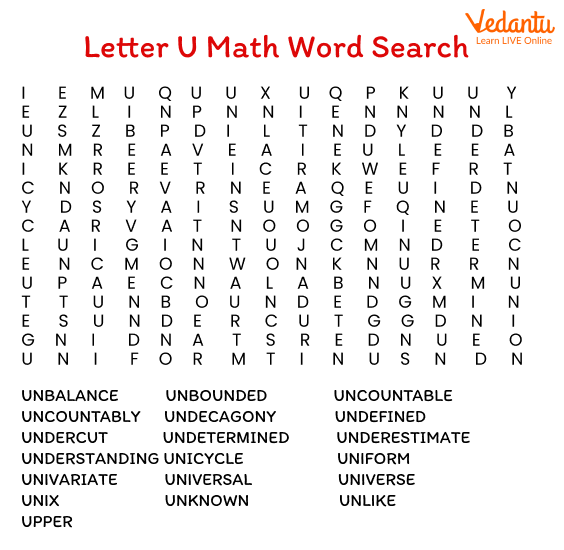




Unlock Understanding: Explore Key Maths Terms Beginning With U
Maths is one subject with lots of recurring terms and abbreviations, which every child cannot get in one go. Also, without knowing these terms, it's really difficult to understand certain Maths concepts and solve problems. So, what's the solution?
We are here to make this challenging task of learning new Maths words easier for children by creating a Maths glossary. In this article, we will learn Maths words that start with U. We have also included a brief description of each of them to help you remember them easily!
10 Maths Words Starting with the Letter U
Let’s get started with new Maths words that start with u.

Maths vocabulary – words starting with ‘u’
Unit: It is a standard quantity used in the measurement. For example, the universal unit of length in metric is the meter, while the units of time are second, minute, hour, etc.
Unitary Method: This is a Mathematical method used in algebra to solve problems involving quantity, where the given quantity is first calculated with respect to ‘one’ unit.
Unequal: In Mathematics, unequal represents the terms, sets, or conditions which are not equal. It is denoted by '≠'.
Undefined Term: In Maths, if the denominator of a fraction is 0, then that term/fraction is called undefined and cannot be solved.
Unlike Fractions: These are fractions with different denominators, no matter what is the numerator. For example, the fractions 11/5 and 5/19 are unlike fractions.
Unit Fraction: A fraction that has 1 in its numerator and any natural number in its denominator. Note that the denominator cannot be 0 or negative integer. For example, 1/8, 1/5, etc.
Undecagon: It is a 2-D polygon with 11 sides and 11 angles. It is also called Hendecagon.

An undecagon
Unknown Variable: In algebra, a variable (usually x, y, or z) is called unknown when its value is not known. We need to find its value.
Unlike Terms: In algebra, unlike terms are defined as the ones which contain different variables or the same variables with different exponents. For example, 3x + 3x2, 4x3 + 5y4, etc.
Universal Set: A set that contains all the elements of the given sets, without any repetition of elements is called a universal set. It is denoted using the symbol U. For example, if A and B are two sets such that A = {1, 2, 3, c} and B = {a, b, c}, then the universal set is given by U = {1, 2, 3, a, b, c}.
Conclusion
These Maths dictionary words starting with the letter ‘u’ introduce kids to many important words and make it really easy for them to memorise. However, it can sometimes become confusing to learn so many words together. So, students should keep repeating words until they become clear.
FAQs on Math Words That Start With U: Simple Definitions for Kids
1. What are some common math words for kids that start with the letter U?
There are several fun and important math words that start with 'U'. Some of the most common ones for kids to learn are:
Under: A positional word that helps describe where an object is, like 'the ball is under the table'.
Unequal: This means two or more things are not the same in value or quantity. For example, 5 is unequal to 2.
Unit: A single, standard quantity used for measurement, like a centimetre, a kilogram, or an hour.
Union: A term used in set theory that means combining all the elements from two or more sets into one.
2. What does the symbol 'U' represent in mathematics?
In mathematics, especially in the topic of Sets, the capital letter 'U' can represent two different but related concepts:
Union of Sets: The symbol '∪' stands for the Union operation. The union of two sets, say A and B, results in a new set that contains all the elements from both A and B, without repeating any common elements.
Universal Set: The letter 'U' is commonly used to denote the Universal Set. This is the main set that contains all the possible elements relevant to a particular problem.
3. How is the term 'unit' used in different math topics?
The word 'unit' is a fundamental concept used in many areas of maths. For example:
In Measurement: It refers to a standard measure, like a metre for length, a gram for weight, or a litre for volume.
In Place Value: The 'ones' place in a number is also called the unit's place. For instance, in the number 125, the digit 5 is in the unit's place.
In Fractions: A unit fraction is a fraction where the numerator is 1, such as 1/2 or 1/4. It represents one part of a whole.
4. Why is a fraction with zero in the denominator called 'undefined'?
A fraction with zero in the denominator is called undefined because division by zero is a mathematical impossibility. Division is the inverse of multiplication. For example, 10 ÷ 2 = 5 because 2 × 5 = 10. If we try to calculate 10 ÷ 0, we would be looking for a number that, when multiplied by 0, gives 10. However, any number multiplied by 0 is always 0, never 10. Since no such number exists, the operation has no meaning, and we call the result undefined.
5. How does the 'unitary method' help solve real-life problems?
The unitary method is a very practical technique for solving problems involving rates and proportions. It works by first finding the value of a single unit, and then multiplying that value to find the required amount. For instance, if you know the price of 6 apples is Rs. 90, you can use the unitary method to find the cost of one apple (90 ÷ 6 = Rs. 15). Once you know this unit cost, you can easily calculate the cost of any number of apples, like 10 apples (10 × 15 = Rs. 150).
6. What is the difference between 'unlike terms' and 'like terms' in algebra?
In algebra, the main difference lies in the variables and their exponents. Unlike terms are terms that do not have the exact same variables with the exact same exponents. For example, 5x and 3y are unlike terms. You cannot add or subtract them directly. In contrast, like terms have the identical variable part, such as 5x and 3x. These can be combined through addition or subtraction (e.g., 5x + 3x = 8x).
7. What does it mean if two values are 'unequal' in maths?
When two values are unequal, it means they do not have the same quantity or value. This concept is fundamental to comparing numbers and expressions. The symbol for unequal is '≠'. For example, the statement '7 + 3 ≠ 12' is true because 10 is not equal to 12. Understanding this helps in solving inequalities and making logical comparisons in various mathematical problems.















